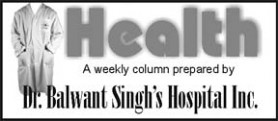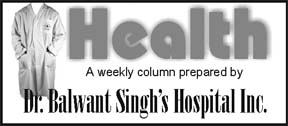Part 2
Dr Anil Menedal, M.S. – (Orthopaedics)
This week we will discuss the common paediatric orthopaedic pro-blems that are associated with the lower limbs.
 Slipped capital femoral epiphysis (SCFE) is an unusual disorder of the adolescent hip. For reasons that are not well understood, the ball at the upper end of the femur (thigh bone) slips off in a backward direction.
Slipped capital femoral epiphysis (SCFE) is an unusual disorder of the adolescent hip. For reasons that are not well understood, the ball at the upper end of the femur (thigh bone) slips off in a backward direction.
The patient’s left hip (arrow) shows that a slight shift of the head of the femur occurred through the growth plate.
The condition is diagnosed based on a careful history, physical examination, observation of the gait/walking pattern, and X-rays of the hip. The X-rays help confirm the diagnosis by demonstrating that the upper end of the thigh bone does not line up with the portion called the femoral neck.
In many cases it is because the patient is overweight for his/her height. In most cases, slipping of the epiphysis is a slow and gradual process. However, it may occur suddenly and be associated with a minor fall or trauma.
The typical patient has a history of several weeks or months of hip or knee pain and an intermittent limp. In certain severe cases, the adolescent will be unable to bear any weight on the affected leg. The affected leg may be turned outward and also appear to be shorter in comparison to the normal leg.
The goal of treatment, which requires surgery, is to prevent any additional slipping of the femoral head until the growth plate closes. If the head is allowed to slip farther, hip motion could be limited. Premature osteoarthritis could develop. Treatment should be immediate.
Early diagnosis of SCFE provides the best chance to achieve the treatment goal of stabilizing the hip.
A screw is inserted to prevent any further slip of the femoral head through the growth plate.
Fixing the femoral head with pins or screws has been the treatment of choice for decades.
There are several potential complications associated with a slipped capital femoral epiphysis. The most common are avascular necrosis (AVN) of the femoral head and chondrolysis.
Avascular necrosis means that the blood supply to the femoral head has been permanently altered by the femoral head slipping. There is no way to identify children at risk for avascular necrosis or to prevent this complication.
Chondrolysis, or loss of articular cartilage of the hip joint, is a major complication of SCFE. It may cause the hip to stiffen with a permanent loss of motion and pain. This is still not fully understood by surgeons. There may be some return of motion.
After surgery, the child will be on crutches for weeks to months. It is important that your child be followed closely for 18 to 24 months after surgery. After the immediate postoperative period, X-rays every three to four months are needed to ensure that the abnormal growth plate has fused.
Perthes Disease
Perthes is a condition in children characterized by a temporary loss of blood supply to the hip. Without an adequate blood supply, the rounded head of the femur dies and becomes flat.
Treatment of Perthes may require periods of immobilization or limitations on usual activities. The long-term prognosis is good in most cases. After 18 months to two years of treatment, most children return to normal activities without major limitations.
Perthes disease usually is seen in children between four and ten years old. The child may show signs of limping and may complain of mild pain. The child may have had these symptoms intermittently over a period of weeks or even months. Pain may be felt in other parts of the leg, such as the groin, thigh, or knee.
X-rays usually diagnose the condition. The child with Perthes can expect to have several X-rays taken over the course of treatment, which may be two years or longer.
Perthes disease involves the patient’s left hip. The other side is normal.
Girls tend to have more extensive involvement; therefore, the expectations (prognosis) are generally poorer than with boys.
For very young children (those two to six years old) who show very few changes on their initial X-rays, treatment is usually simply observation.
The older child is treated in order to improve the hip’s range of motion.
Nonsurgical treatment
Anti-inflammatory medications, such as ibuprofen, are used. These medicines are often used for months.
To help restore hip joint range of motion, the child may be encouraged to walk with crutches and participate in physical therapy. Bed rest in traction may be needed in some cases, however.
If range of motion becomes limited or if X-rays or MRIs indicate that a progressive deformity is developing, a cast may be used to keep the head of the femur within the acetabulum, or hip socket.
Petrie casts keep the legs spread far apart in an effort to maintain the hips in the best position for healing.
Surgical treatment
An osteotomy to the left hip puts the femoral head in a better position to heal.
Surgical treatment re-establishes the proper alignment of the bones of the hip. The head of the femur is placed deep within the socket, or acetabulum. This alignment is kept in place with screws and plates, which will be removed at a later time. The child is often placed in a cast from the chest to the toes for 6 to 8 weeks.
Osgood-Schlatter Disease (Knee Pain)
Osgood-Schlatter disease is an overuse injury that occurs in the knee area of growing adolescents. It is caused by inflammation of the tendon below the kneecap (patellar tendon) where it attaches to the shinbone (tibia). Young adolescents who participate in certain sports, including soccer, gymnastics, basketball, and distance running, are most at risk for this disease.
Left: The tendon below the kneecap (patellar tendon) attaches to the shinbone (tibia) at the tibial tubercle.
Right: In Osgood-Schlatter disease, the enlarged, inflamed tibial tubercle is nearly always tender when pressure is applied.
Once a diagnosis has been made, treatment is aimed at reducing the pain and swelling. This may include the use of non-steroidal anti-inflammatory drugs and wrapping the knee until the child can enjoy activity without discomfort or significant pain afterwards.
Symptoms that worsen with activity may require rest for several months, followed by a conditioning programme. In some patients, Osgood-Schlatter symptoms may last for two to three years. However, most symptoms will completely disappear with completion of the adolescent growth spurt, around age 14 for girls and age 16 for boys.

